- Home
- The Autumn Garden
- Fall Perennials E-O
Fall Perennials E - O
The list of fall perennials continues . . .
Epimedium x ‘Domino,’ hybrid epimedium, Zones 5-8. Epimediums bloom in spring, but if the conditions are right, some may surprise with brilliant fall color such as this ‘Domino.’
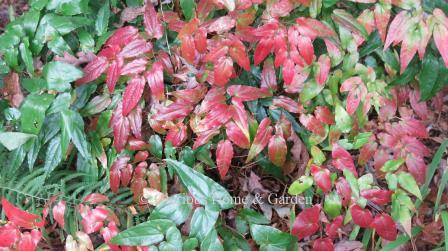 Epimedium x 'Domino'
Epimedium x 'Domino'Eurybia divaricata, white wood aster, Zones 3-8. White wood aster is a native of the eastern U.S., and makes a wonderful addition to the perennial border or the edges of woodland areas. A prolific bloomer, it flowers from late summer and well into October. The small white starry flowers have yellow centers and are enticing to pollinators. It is an excellent choice for difficult dry shady areas where it can be allowed to spread.
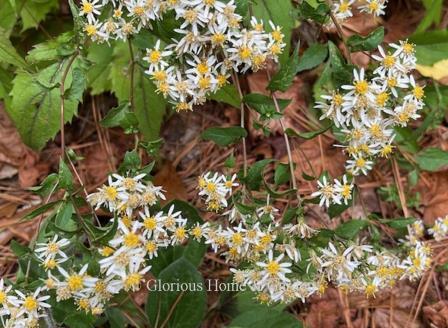 Eurybia divaricata
Eurybia divaricataFarfugium japonicum 'Giganteum,' giant leopard plant, Zones 7-9. I first saw this at the Atlanta Botanical Garden where they have used it extensively in the new Southern Seasons Garden, and said "What is that!" A type of ligularia, this species has huge, thick, rounded heart-shaped, glossy green leaves forming a huge clump. Tall stalks of yellow daisy-like flowers top it in late October into November.
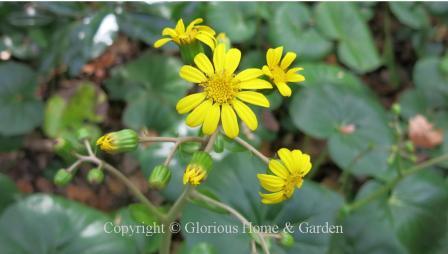 Farfugium japonicum 'Giganteum'
Farfugium japonicum 'Giganteum'Gentiana andrewsii, bottle gentian, Zones 3-7. This fall-blooming perennial is a native of northeastern and midwestern North America. The curious dark blue flowers are clustered at the top of the stem and swell like bottles, but never open. If you can provide the moist soil, good drainage and cool temperatures it prefers, the blue of the flowers is beautiful. Not a good plant for the south.
Helenium autumnale, sneezeweed, Zones 3-8. Poor sneezeweed, like goldenrod, has the rep for causing hayfever, but the culprit is really ragweed which blooms at the same time. A native of eastern North America, sneezeweed blooms in late summer into autumn in perfect autumnal colors of red, orange, and yellow. The large domed centers resemble coneflowers, but the array of petals with lobed, toothy tips are distinctive. This plant gets large (3-5') and can be invasive, so dig and divide every couple of years to keep in check.
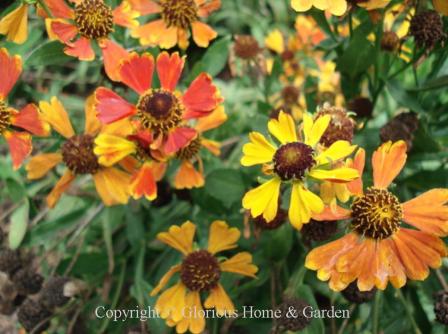 Helenium autumnale
Helenium autumnaleHelianthus angustifolius, swamp or narrow leaf sunflower, Zones 6-9. At 5-7' tall, with cheery bright golden yellow blooms, this sunflower really creates an impact in the fall garden. This one at Tryon Palace in New Bern, N.C.
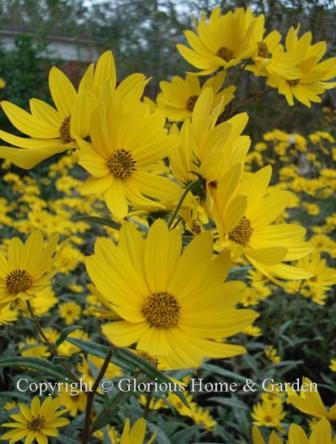 Helianthus angustifolius
Helianthus angustifoliusHelianthus giganteus, giant sunflower, Zones 5-9. I've not seen this sunflower in person, but I understand that it can get 7-10'! Unlike the giant annual sunflower (Helianthus annuus) that produces huge flowerheads, this fall-blooming perennial produces a profusion of 2" flowers.
Helianthus salicifolius, willowleaf sunflower, Zones 5-9. Willowleaf sunflower is similar to swamp sunflower, but has narrower leaves and is a bit hardier. 'Lemon Queen,' here at the Atlanta Botanical Garden, is a good selection. Butterflies love it!
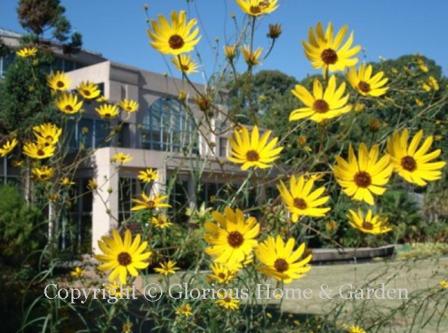 Helianthus salicifolius
Helianthus salicifoliusHibiscus mutabilis, Confederate rose, 7-10. Not a rose at all, but a mallow, Confederate rose is fascinating for its large, showy rose-like blooms that change color from white to pale pink to deep rose as the day progresses.allow, There are single and double forms, and some, such as "Plenus' (shown below), or 'Rubrum' that do not change color. This late-summer-to-fall-blooming perennial can grow into a large, shrubby plant of up to 15.'
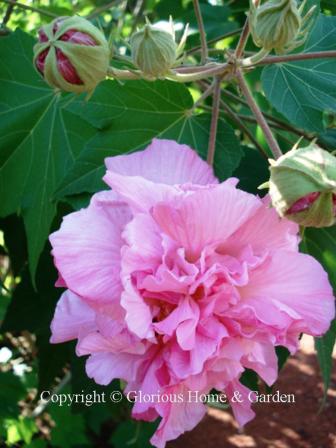 Hibiscus mutabilis
Hibiscus mutabilisHylotelephium, sedum or stonecrop Zones 3-8. The taxonomists have been at it again! Recent DNA testing has led to reclassifications and renaming of genuses, so now these larger sedums are called hylotelephiums, which is a mouthful. Whatever you call them, they are the same plants and are wonderful in the fall garden with their rounded flowerheads and fleshy succulent leaves—bees and butterflies love them. There are several outstanding cultivars. 'Autumn Joy' (‘Herbstfreude’) is a cornerstone of the fall border. The flowers change color from palest pink to rose and finally copper-red as they mature--they sort of look like pink broccoli. 'Autumn Fire' is a newer cultivar with deeper colored rosy flowers than 'Autumn Joy' that last longer into the fall. ‘Frosty Morn’ is a new look in sedums with very pale pink flowers and variegated foliage. 'Matrona' has dark wine-red stems and blue-green leaves with a hint of purple. The pink flowerheads, which are darker and looser than ‘Autumn Joy,’ are borne above the foliage on tall stems. An outstanding color combination.
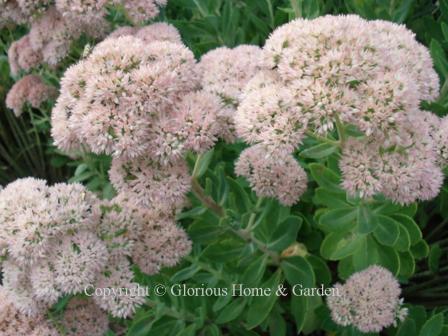 Sedum x 'Autumn Joy'
Sedum x 'Autumn Joy'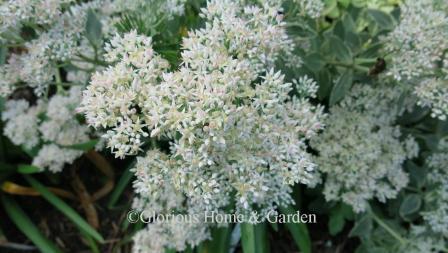 Sedum 'Frosty Morn'
Sedum 'Frosty Morn'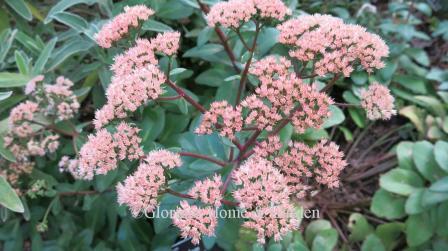 Sedum 'Matrona'
Sedum 'Matrona'Reblooming Iris
Irises are so beautiful that it is worth trying a few of the reblooming ones to enjoy them again in late summer or fall. Some varieties are more reliable than others, but the reblooming trait seems to depend on a lot of factors including zone, climate, temperature and culture. Most of the reblooming types are among the tall bearded hybrids, but there are also some remontant types in other bearded irises and Siberian irises. Here are a few tall bearded iris hybrids said to be reliable rebloomers. Consult the Reblooming Iris Society, www.rebloomingiris.com, for more information.
Autumn Circus--blue-violet and white plicata, early season
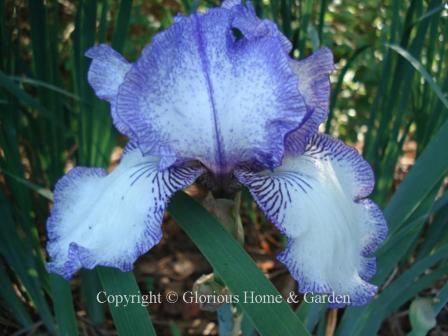 Iris germanica 'Autumn Circus'
Iris germanica 'Autumn Circus'Autumn Tryst--lavender/white plicata, mid season
Best Bet--light blue standards with dark blue falls, early season
Breakers--blue self, mid to late season
Champagne Elegance--white standards with apricot falls, mid season
Clarence--light blue and white bitone, early season
Harvest of Memories--yellow self, mid season
Immortality--white self, mid season
Jennifer Rebecca--pink, mid season
Mother Earth--light pink standards with darker lilac falls, mid to late season
Pagan Dance--dark violet w/black center on falls, early to mid season
Rosalie Figge--dark violet, late season
Sugar Blues--blue, mid to late season
Total Recall--soft yellow standards, white falls w/yellow edge
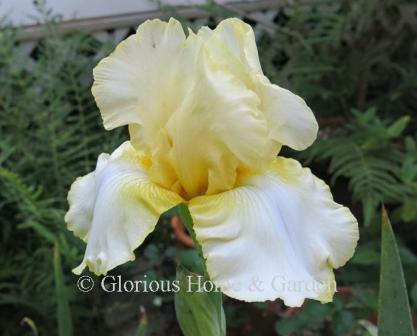 Iris germanica 'Total Recall'
Iris germanica 'Total Recall'Kalimeris pinnatifida, Japanese aster, Zones 4-8. This Japanese native has fluffy double white blooms with yellow center, somewhat resembling a miniature chrysanthemum. These are trouble-free, easy-to-grow plants that do best in full sun with good drainage, and bloom from late summer into autumn.
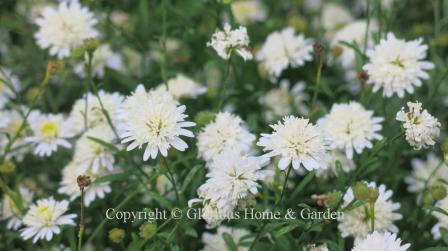 Kalimeris pinnatifida
Kalimeris pinnatifidaLespedeza thunbergii, Thunberg bush clover, Zones 4-7. The shrubby perennial produces long arching stems laden with pea-like rose-pink flowers.
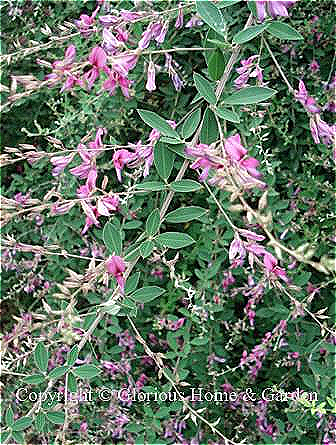 Lespedeza thunbergii
Lespedeza thunbergiiMuhlenbergia capillaris, pink muhly grass, Zones 7-9. This lovely grass, neat and quiet all summer, creates quite a show when it blooms in the fall. The airy sprays of pink flowers on wiry stems are stunning and long lasting. Great used en masse.
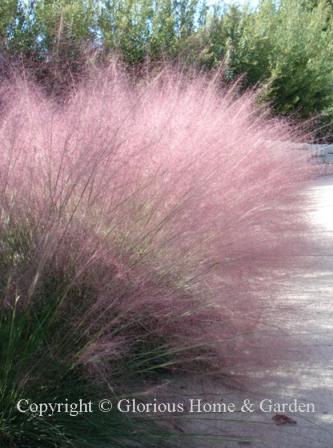 Muhlenbergia capillaris
Muhlenbergia capillarisNipponanthemum nipponicum, Nippon or Montauk daisy, Zones 5-9. This mum has attractive foliage that is topped with large, white daisy-like flowers with greenish-yellow centers in late fall, blooming until frost.I saw them everywhere on a recent trip to Cape Cod and Nantucket. Full sun and good drainage are essential.
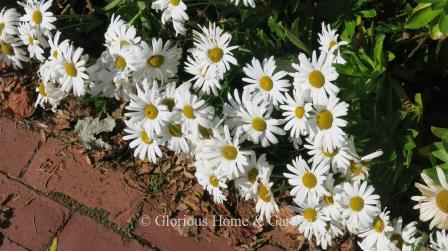 Nipponanthemum nipponicum
Nipponanthemum nipponicumReturn to Fall Perennials A - D
Plant of the Month
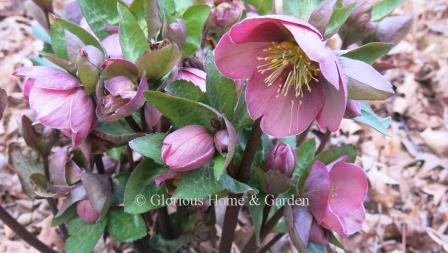
Helleborus x iburgensis
'Pippa's Purple'
Updated new USDA Plant Hardiness Zone Map 2023.